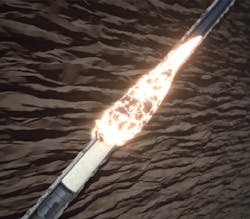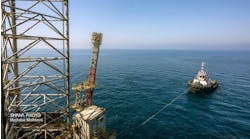Government-supported initiative speeding development of North Sea technologies
Goals include improved drilling, inspection efficiency
Jeremy Beckman
Editor, Europe
The Oil & Gas Technology Centre in Aberdeen is a new initiative working to foster innovation in the UK offshore sector and help the industry improve recovery of the North Sea’s remaining resources.Offshorespoke to Chief Executive Colette Cohen about the Centre’s goals and achievements to date, which include over £15 million [$19.8 million] co-invested with the industry, a program to fund and support smaller companies develop their businesses and promising new technologies, and the recently opened Innovation Hub.
•••
Offshore: What was the rationale behind the formation of the Oil & Gas Technology Centre, and when did the process of forming the centre begin? Was this prior to Sir Ian Wood’s proposals for MER UK?
Cohen: In his 2014 Maximising Economic Resourcesreview for the UK Continental Shelf (MER UK), Sir Ian Wood made a number of recommendations. This led to the creation of the Oil & Gas Authority, a progressive new regulator for the UK oil and gas industry. Sir Ian also identified the need for a greater focus on technology on the UKCS, which was the initial inspiration for the Oil & Gas Technology Centre.
A business case for the Centre was developed as part of an Aberdeen City Deal proposal, which was signed by the UK and Scottish governments in November 2016. With £180 million [$239 million] allocated by the two governments under a 50/50 arrangement, the Technology Centre received the lion’s share of the £210 million [$277 million] granted to the City Deal. Work to develop the Centre began in late 2016 and it officially opened for business in February 2017.
The £180 million funding is over a 10-year period, with the requirement for this to be match funded by the industry – either in-kind or cash. So far, the Centre has invested more than £15 million [$20 million] with 60% leveraged from industry partners.
Offshore: Was there a clear plan from the outset of the various initiatives that would be developed?
Cohen: The industry’s Technology Leadership Board provided the Centre’s initial five areas of focus – asset integrity, well construction, marginal discoveries (small pools), decommissioning, and digital transformation. The Technology Leadership Board will continue to provide strategic input on key themes and challenges. The Centre also has a Call for Ideas process to identify solutions for the challenges faced by the industry.
The Centre works with its members to shape its work programs and focus areas, creating projects in partnership with operators, service companies and technology providers to accelerate the pace of new technologies.
The drillstem testing version of Raptor Oil’s advanced acoustic downhole modem tool. (Images courtesy Oil & Gas Technology Centre)
Offshore: How many companies, academic institutes provided input to the proposed Centre and its future direction?
Cohen: There was extensive engagement with more than 50 institutions and industry organizations during the development of the business case.
Offshore: How many members does the centre have at present, and what are the benefits of participation?
Cohen: The Centre has more than 50 members. We have £180 million to co-invest with our partners to get innovative technologies to market quicker. Our members help to shape the base portfolio of projects invested in by the Centre, but the Centre also invests with many non-members on projects which fit the Technology Strategy which supports MER UK.
There are four ways for companies to get involved, and each one can combine in-kind funding with cash funding in arrears.
Offshore: What is the purpose of the recently opened Innovation Hub?
Cohen: This is a state-of-the-art facility, opened by Scotland’s First Minister on October 2, to drive innovation and accelerate new technologies to help unlock the full potential of the UK North Sea. The Hub brings industry and technology providers together, connecting problems with solutions and solutions with problems. By partnering with industry, academia and experts from outside oil and gas, we help innovators make their ideas tangible, prove the value of their concepts, and prepare them for deployment in the oilfield.
Our program of innovation events and workshops is driven by the needs and priorities of the industry. The Hub provides the tools and techniques to stimulate and capture creative contributions of participants, accelerating ideas into actions.
Offshore: Can you provide details of the Asset Integrity and Well Construction Solutions Centres and the types of projects under development?
Cohen: The Solutions Centres are based at our Queen’s Road site in Aberdeen and are teams of employees that manage the projects the Technology Centre invests in. One of our key projects deal with asset integrity. In partnership with Infinity Oilfield Services, we are developing a safety solution that could save UK North Sea operators up to £320 million [$425 million]. The device, which includes Kevlar, would contain corroded valve equipment to eliminate the risk of an uncontrolled hydrocarbon release, improving safety performance and potentially extending asset life.
Apollo and LifeTech are developing a tablet-based, software solution for integrity management. It delivers integrity data and decision-making across the full lifecycle of an asset, allowing for quicker and more accurate data gathering and reporting, creating a potential 20% efficiency gain.
Air Control Energy aims to deliver a step change in the capability and functionality of unmanned aerial vehicles (UAVs) for the remote inspection of oil and gas facilities. These advanced drones could be 20 times faster than traditional inspection techniques and reduce costs by 50% in comparison to rope access methods.
The Centre is also working with TRAC Oil & Gas to develop a new electromagnetic method to inspect corroded pipework under insulation and composite wrap materials. This innovative solution would enable companies to monitor the condition of hidden pipework, saving time and money compared to current approaches.
Well construction is another key focus area. With the Centre’s support, Raptor Oil has a program that could transform the transmission of downhole drilling data to the surface. The company’s acoustic telemetry technology could increase the speed and capacity of data communication, helping to drive efficiency, reduce costs, and improve decision-making.
We are working with Interwell P&A and various major North Sea operators to field-trial a ground-breaking concept for well abandonment that could save the industry more than £100 million [$133 million] per year. The wireline-deployed tool (a rig-less deployment is targeted), generates downhole temperatures of up to 3,000°C [5,432°F] to melt all well elements and create a permanent, impermeable barrier, without the need to remove any downhole tubulars.
Using technology to transform the construction and operation of wells could reduce costs by up to 50%. To support this, the Centre is co-funding a project with Deepwater Oil Tools to develop a special articulated joint called ArticuLock, which could enable drilling operations in rough weather conditions, saving tens of millions of pounds each year.
Interwell’s wireline-deployed tool creates a permanent barrier, without the need to remove downhole tubulars.
Offshore: Can you explain how the Asset Integrity Solutions Centre (AISC) will work to achieve its goal to “eliminate the impact of asset integrity on operational uptime by 2026”?
Cohen: Corrosion has significant impact on uptime and operating performance. Corrosion costs the global economy £4 trillion/yr [$5.31 trillion] and £28 billion [$37.21 billion] annually in the UK. Around 60% of pipe failures on UKCS infrastructure are due to corrosion under insulation, while the annual UKCS cost of vessel inspection and corrosion under insulation is £300 million [$398 million].
The AISC wants to transform the way the industry maintains its assets by identifying, co-funding, developing, and deploying new technology in the North Sea. The opportunity, if this can be achieved, is significant:
• Potential production value increase of £157 million [$208 million] with alternative methods to vessel inspection
• £700 million [$930 million] economic benefit of improved asset integrity technologies between 2016 and 2025
• £14 million [$18.6 million] investment required meaning every £1 investment unlocks £50 [$66] net gain.
The AISC is initially focused on the two themes identified in the Asset Integrity Theme Landscaping Study, commissioned by Oil & Gas UK on behalf of the Technology Leadership Board. These themes are process vessel inspection (VI) and corrosion under insulation (CUI). Eliminating the impact of asset integrity on operational uptime by 2026 means no shutdowns or lost production due to asset integrity issues by that date.
Offshore: The Centre periodically launches “calls for ideas.” What are the goals for the selected technologies?
Cohen: The goals vary depending on the technology readiness level of the ideas that we decide to invest in. The goal of an idea with a low TRL [Technology Readiness level] could be to prove the concept or develop a working prototype; a goal for an idea with a higher TRL could be to take the technology to field trial.
Offshore: What is the purpose of the Tech X Technology Accelerator?
Cohen: TechX, due to be launched in December, is an initiative designed to stimulate and accelerate new technology business anchored in northeast Scotland.
Our goal is to invest in 100 technology companies in the next decade, offering:
• Unparalleled funding, up to £100,000 [$133,000] per start-up, with no equity or pay back required
• Mentoring: advice and support from an extensive network of experienced mentors and partners
• Facilities: fast access to dedicated facilities and tailored training
• Field testing: opportunities to field trial through the Centre’s operator network.
There are three available funding programs to accelerate the development and deployment of new technology:
For start-ups, there is our Pioneers program. Mentoring and support for entrepreneurs to develop business, validate products, acquire customers and attract funding. Each Pioneer will receive up to £100k funding and can work out of the TechX space at the Technology Centre’s site in the heart of Aberdeen. There are two programs each year, with 10 companies per program.
For subject matter experts, there is our Market Entry program. This is an ongoing program for companies with a unique and near market-ready product – preferably from a different industry, needing operational testing, validation and scaling.
Then, there is our Ventures program. This program is designed for new ventures that are looking to fill technology and supply chain gaps through creativity, innovation and determination. This is a six to nine-month program that runs in partnership withDeep Science Ventures in London.
Offshore: What are the aims of the Small Pools Initiative?
Cohen: The Small Pools Solution Centre, like the Asset Integrity, Well Construction, Decommissioning and Digital Solutions Centres, helps identify, co-fund, develop, and deploy new technology in the North Sea. The goal is to have no technically stranded UK offshore field assets by 2022.
The Small Pools Solution Centre has co-invested in two projects to date: one is with Exnics to develop a unique subsea flow meter that can be retrofitted to measure oil and gas flow rates from subsea wells. Improving measurement was one of the key focus areas identified by the industry’s Technology Leadership Board.
Another project, with EC-OG, is in the preparatory phase for a field trial of the company’s subsea power hub – a subsea generation and storage device which harnesses ocean currents to provide the power needed to operate well controls and other critical subsea equipment.
The Small Pools ‘Tie-back of the future’ initiative involves 25 companies, with 15 technology proposals and six integrated studies to design new tiebacks that can be delivered for half the cost in half the time, and significantly reduce the impact on the environment. The initiative focuses on designing for disassembly and re-use, contributing to the circular economy and reducing waste.





